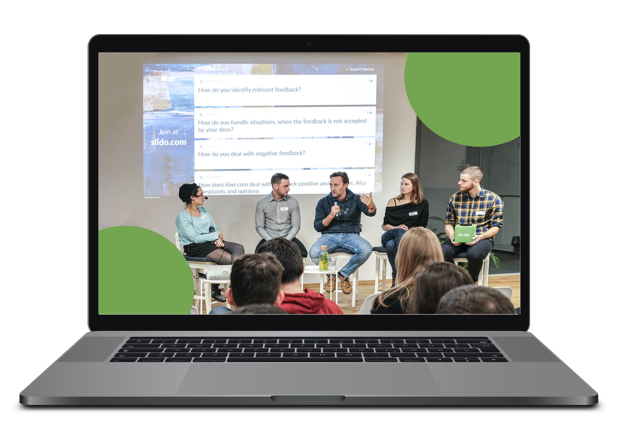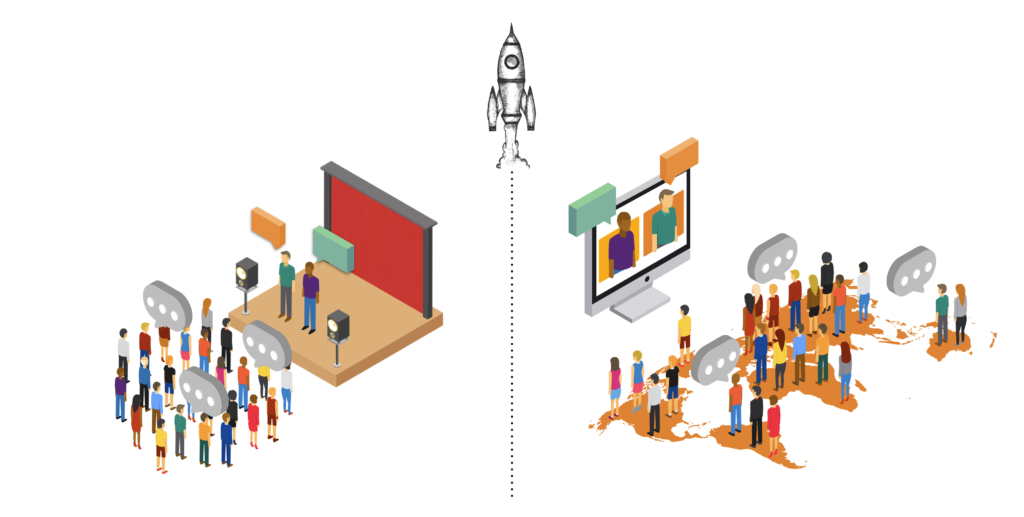Virtual vs. In Person vs. Hybrid Events
Feb 17 2022, sponsored by nanocosmos
how Do we reach as many people as possible and how do we provide everybody the best experience we can give them – whether they are in the room or watching online?
The panel discussion started with one thing that is clear: There is no way of going back to the way things were before the pandemic. Event planners, performers, producers, sports teams, venues and last but not least attendees deal with a new events’ landscape. Be it production or distribution – we have to figure out what our target group expects, how we can reach them and how to navigate through the requirements of our events to deliver the best quality possible.
Eric Schumacher-Rasmussen, VP & Editor-in-Chief – Streaming Media
Andy Howard, Founder & Managing Director – Howard & Associates
Mindi Sue Sternblitz-Rubenstein, VP of Marketing – Parks Associates
Oliver Lietz, CEO – nanocosmos
KEY TAKE AWAYS
TOPICS DISCUSSED
How to manage hybrid or virtual events successfully?
- Let’s start with definitions. We all know what an in-person event is, and we all know what a virtual event is.
But what do we mean by hybrid event?
A hybrid event is a mix of an in-person and virtual event, like a live panel discussion on stage which has both in-person attendees and people joining online. These might be online panelists and also attendees watching the session and interacting by asking questions or giving feedback of any form. - With all the upside of virtual events, why are we all pushing for a return to in-person? What are the drawbacks to virtual? How has this changed and what is this new trend towards lean-forward experiences?
People have been used to virtual meetings now. Virtual events present a lot of opportunities but also a major drawback: they lack the sense of community with audience engagement and feedback that real-life events naturally enable. This is the main reason people are asking for in-person meetings again, the informal and social parts of these meetings make it more valuable. Thus, in-person events will return, but it would be a missed opportunity to not keep online and virtual audiences included. The event sizes can triple with a global audience, less traveling as many people cannot or do not want to travel, you can keep a global audience engaged to your topics. it is easier to pivot on any changes (e.g. additional speakers or experts joining online, changed presentations). - Let’s turn to hybrid events, which present a tremendous challenge to pull off successfully. What are the key elements to make hybrid events successful and how can we reach a large audience outside a venue or virtual meeting room, and still ensure to keep the audience engaged with an interactive experience?
In-person events currently still deliver the strongest engagement factor while virtual events reach larger target groups and work well for educational purposes, offer convenience and accessibility. The combination of hybrid events are meant to reach both goals, which is challenging but creates new opportunities. There are several requirements: you need to keep a close interaction alive, and make the event a real active, lean-forward experience with a great user experience to keep up the audience engaged. Existing business models can be expanded, by adding interactive components for Q&A, polls, or even sales activities. This creates chances for better monetization of your live content.
- What are the technical challenges involved in successful virtual or hybrid event production and distribution?
For the producers and platform providers this means easy integration into their platforms based on the right technology partner which can provide a reliable distribution technology (network, CDN, player and tools) for ultra-low-latency live streaming with large global outreach and easy access to enable realtime interaction. Valuable data metrics and analytics are required for business evaluation and improvements, to keep a great quality of service and quality of experience. Ideally, the events are available for immediate and easy access without app download, preferably on any device directly in the browser. Usability is a challenge and there is a lot room for improvement for event platforms!
- Big picture: What does the future of live events look like?
A full “hybrid” experience as combination of in-person and virtual events creates new opportunities for vendors to reach and engage their audiences. We are just at the beginning. Looking at platforms like Zoom, they are great tools to host virtual video meetings, but there is still a gap for audience engagement on a integrated and branded environment with easy access for any person to join the event on larger scale. Platforms like nanoStream Cloud can be used or integrated with meeting platforms like Jitsi or Zoom, to combine the realtime communication of a panel discussion with audience engagement in your own branded environment on any device with easy access.


Oliver Lietz
CEO, ![]() nanocosmos
nanocosmos
 Bio: Oliver Lietz founded
Bio: Oliver Lietz founded ![]() nanocosmos in 1998 with a strong background in video R&D for video/audio coding and streaming for the broadcast industry. Since then he has been focusing on developing solutions that integrate video technology into custom business applications.
nanocosmos in 1998 with a strong background in video R&D for video/audio coding and streaming for the broadcast industry. Since then he has been focusing on developing solutions that integrate video technology into custom business applications.
nanocosmos, a Berlin based company, is a proud sponsor of the event. nanocosmos offers nanoStream Cloud, an integrated, white label, ultra-low-latency live streaming solution that covers key requirements for global live streaming applications with audience interaction. Instant live streaming at any scale, live playback on all browser platforms, and devices are made available to B2B partners and platform providers. nanoStream Cloud was awarded 2021 to be the best Corporate Video Platform by Streaming Media European Readers’ Choice Award.

